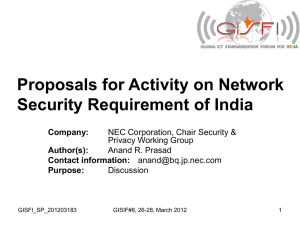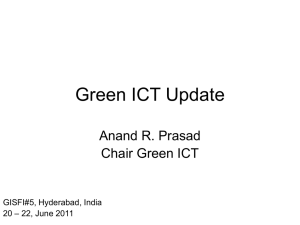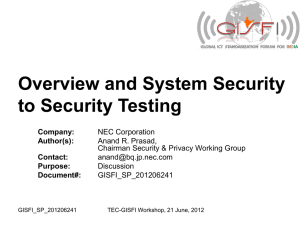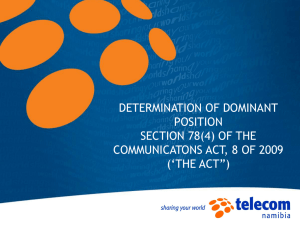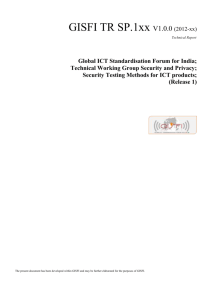Approach Towards Implementation of Green Telecom in India
advertisement
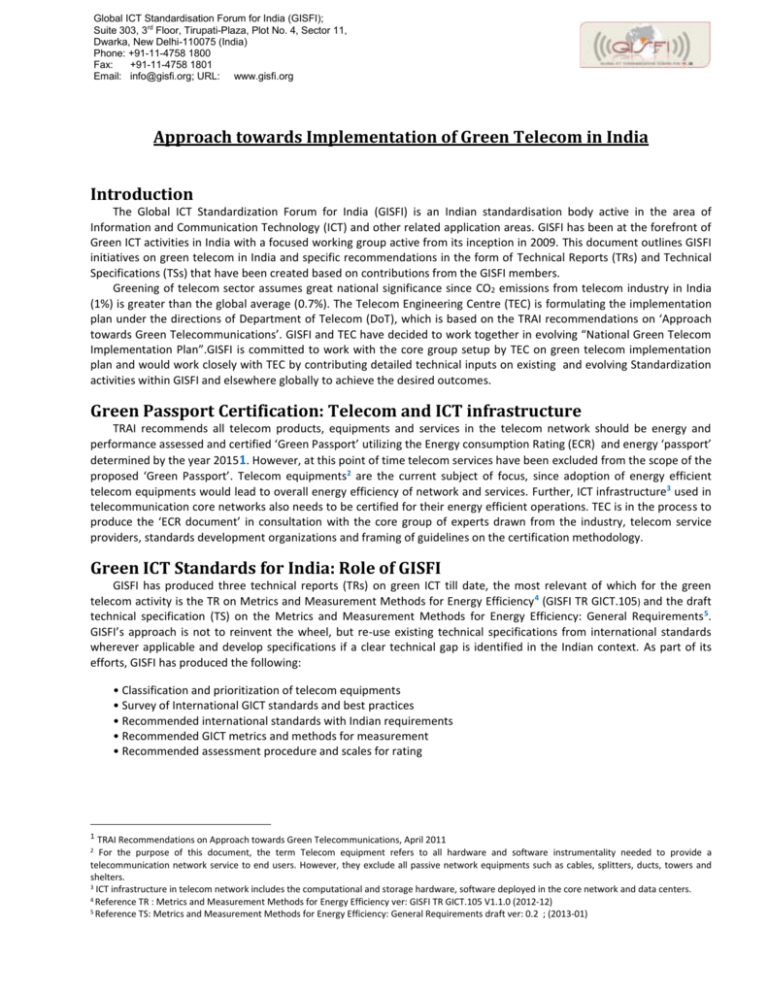
Global ICT Standardisation Forum for India (GISFI); Suite 303, 3rd Floor, Tirupati-Plaza, Plot No. 4, Sector 11, Dwarka, New Delhi-110075 (India) Phone: +91-11-4758 1800 Fax: +91-11-4758 1801 Email: info@gisfi.org; URL: www.gisfi.org Approach towards Implementation of Green Telecom in India Introduction The Global ICT Standardization Forum for India (GISFI) is an Indian standardisation body active in the area of Information and Communication Technology (ICT) and other related application areas. GISFI has been at the forefront of Green ICT activities in India with a focused working group active from its inception in 2009. This document outlines GISFI initiatives on green telecom in India and specific recommendations in the form of Technical Reports (TRs) and Technical Specifications (TSs) that have been created based on contributions from the GISFI members. Greening of telecom sector assumes great national significance since CO2 emissions from telecom industry in India (1%) is greater than the global average (0.7%). The Telecom Engineering Centre (TEC) is formulating the implementation plan under the directions of Department of Telecom (DoT), which is based on the TRAI recommendations on ‘Approach towards Green Telecommunications’. GISFI and TEC have decided to work together in evolving “National Green Telecom Implementation Plan”.GISFI is committed to work with the core group setup by TEC on green telecom implementation plan and would work closely with TEC by contributing detailed technical inputs on existing and evolving Standardization activities within GISFI and elsewhere globally to achieve the desired outcomes. Green Passport Certification: Telecom and ICT infrastructure TRAI recommends all telecom products, equipments and services in the telecom network should be energy and performance assessed and certified ‘Green Passport’ utilizing the Energy consumption Rating (ECR) and energy ‘passport’ determined by the year 20151. However, at this point of time telecom services have been excluded from the scope of the proposed ‘Green Passport’. Telecom equipments2 are the current subject of focus, since adoption of energy efficient telecom equipments would lead to overall energy efficiency of network and services. Further, ICT infrastructure3 used in telecommunication core networks also needs to be certified for their energy efficient operations. TEC is in the process to produce the ‘ECR document’ in consultation with the core group of experts drawn from the industry, telecom service providers, standards development organizations and framing of guidelines on the certification methodology. Green ICT Standards for India: Role of GISFI GISFI has produced three technical reports (TRs) on green ICT till date, the most relevant of which for the green telecom activity is the TR on Metrics and Measurement Methods for Energy Efficiency 4 (GISFI TR GICT.105) and the draft technical specification (TS) on the Metrics and Measurement Methods for Energy Efficiency: General Requirements 5. GISFI’s approach is not to reinvent the wheel, but re-use existing technical specifications from international standards wherever applicable and develop specifications if a clear technical gap is identified in the Indian context. As part of its efforts, GISFI has produced the following: • Classification and prioritization of telecom equipments • Survey of International GICT standards and best practices • Recommended international standards with Indian requirements • Recommended GICT metrics and methods for measurement • Recommended assessment procedure and scales for rating 1 TRAI Recommendations on Approach towards Green Telecommunications, April 2011 For the purpose of this document, the term Telecom equipment refers to all hardware and software instrumentality needed to provide a telecommunication network service to end users. However, they exclude all passive network equipments such as cables, splitters, ducts, towers and shelters. 3 ICT infrastructure in telecom network includes the computational and storage hardware, software deployed in the core network and data centers. 4 Reference TR : Metrics and Measurement Methods for Energy Efficiency ver: GISFI TR GICT.105 V1.1.0 (2012-12) 5 Reference TS: Metrics and Measurement Methods for Energy Efficiency: General Requirements draft ver: 0.2 ; (2013-01) 2 Global ICT Standardisation Forum for India (GISFI); Suite 303, 3rd Floor, Tirupati-Plaza, Plot No. 4, Sector 11, Dwarka, New Delhi-110075 (India) Phone: +91-11-4758 1800 Fax: +91-11-4758 1801 Email: info@gisfi.org; URL: www.gisfi.org Classification and prioritization of telecom equipments Classification of telecom equipment for Green Passport certification As a starting point to this activity, it is important to classify the telecom equipments based on their functions and mode of operations. The GISFI TR4 provides the detailed classification of telecommunication equipments for both wired and wireless networks, broadly classified into access, transport and core network as well as data center equipments. Further, the TR4 also provides the details of the relevant international standards and best practices on energy efficiency applicable to each class of equipments. Prioritization of telecom equipment for Green Passport certification The landscape of telecom equipments deployed by Indian service providers is very extensive 6 and it is important to prioritize the equipments based on their severity of impact on carbon emissions to provide impetus to the green telecom activity. From the TRAI report, the 2G/2.5G and 3G wireless access networks are the major contributors to the carbon emissions and hence are considered to be on the top priority in the “Green Passport” agenda. Further a detailed classification and prioritization document based on national relevance and technological feasibility would be produced. Survey of International GICT standards and best practices International GICT standards and best practices baseline for developing Indian specifications The GISFI TR4 presents a summary of international GICT standards and their applicability to the various classes of telecom equipments identified. The ETSI, ATIS and ITU are the three major global standards organizations which have produced specifications on energy efficiency metrics and methods of assessment for telecom equipments (both circuit and packet switched). The ECR Initiative has produced an open specification of energy efficiency metrics and measurement for packet switched equipment. The Japanese ICT guideline council has also released guidelines for vendors and service providers to certify energy efficient equipments. More details can be found in GISFI TR4. Recommended international standards with Indian requirements The surveyed international standards on energy efficiency of telecom equipments address majority of issues related to GICT standards for India as well. The GISFI TS5 recommends the general requirements for measurement setup, configuration, environmental conditions, metrics definition and test reporting format based on these international standards. The supplementary standards would address the specific details applicable to each of the classes of telecom equipments. However, it is found that the ECR as defined by ECR initiative is applicable only to the packet switched equipments and cannot be applied directly to the circuit switched equipments like 2G/2.5G radio base stations which appear on the top priority for the implementation of “Green Passport”. Hence, GISFI would consider this gap as well as other India specific requirements and propose new GICT standards. Recommended GICT metrics and methods for measurement The generalized definition of ECR is average power consumption of the equipment normalized to throughput and has a physical meaning of energy consumed to move one unit of data per second. The TEC and GISFI would work together to define the suitable metric (throughput and useful work done) based on ECR as well as the method of measurement for 2G/2.5G Base Stations and other circuit mode telecom equipment deployed in Indian telecom networks. Further, for class of equipments where ECR is not a suitable metric (ex: data center storage, computational equipments like servers, mobile core network elements), new metrics based on international best practices need to be provided. For each class of equipment, the measurement and reporting procedures also need to be defined. Recommended assessment procedure and scales for rating “Green Passport” certification requires assessment procedures and rating methods for all the telecom equipments. Collection of relevant vendor declared information on energy consumption for each class of equipments at the initial stage is advised. Based on the declared figures, a statistical estimate of the value of the metric needs to be computed that will be the baseline normative reference. A rating method can be based on the levels indicated by the number of stars (★) (More details can be found in GISFI TS5). The greater the number of stars, the greater would be the energy 6 Reference: Presentation to the TEC Core committee GISFI_GICT_201211321.pptx Global ICT Standardisation Forum for India (GISFI); Suite 303, 3rd Floor, Tirupati-Plaza, Plot No. 4, Sector 11, Dwarka, New Delhi-110075 (India) Phone: +91-11-4758 1800 Fax: +91-11-4758 1801 Email: info@gisfi.org; URL: www.gisfi.org efficiency. The certification and assignment of the star rating need to be carried out by the appropriate test and certification laboratory at TEC or TEC approved testing and certifying laboratory. Conclusion To conclude, this document outlines the TEC & GISFI Joint initiatives on green telecom in India and specific recommendations produced on standards and measurement metrics. Further time plan and specific details need to be worked out in consultation with the core committee to meet the vision of “Green Passport implementation by 2015”. GISFI would pro-actively lead the activity by providing the appropriate technical inputs in form of Indian GICT standards and technical recommendations.
